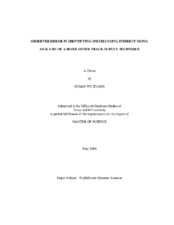| dc.description.abstract | Indirect signs of species presence (e.g., tracks, scats, hairs) are frequently used to
detect target species in occupancy, presence/absence, and other wildlife studies. Indirect
signs are often more efficient than direct observation of elusive animals, making such
signs well suited for long-term and broad-scale monitoring programs. However, error
associated with misidentification of indirect signs can be high, and should be measured
if meaningful inferences about population parameters are to be made. This study
addressed the need for systematic approaches to estimate and minimize variation due to
observer error in identifying indirect signs. I reanalyzed data from 4 replicates of a
presence/absence survey of northern river otters (Lontra canadensis) that had been
conducted by Texas Parks and Wildlife Department (1996-2003). Sixteen observers had
recorded tracks at sample points under bridges (n = 250) distributed throughout 27
counties in the Piney-Woods ecoregion of east Texas. My objectives were to 1)
determine if observers were a source of bias in the survey, 2) estimate the proportion of
error associated with track identification skill, and 3) evaluate the use of an international
certification procedure that measured observer tracking skill. The null hypothesis that observers had no effect on the variation in reported sign was rejected. Indeed, binary
logistic regression tests indicated that observers were significantly associated with
variation in reported track presence. Observers were not randomly distributed among
bridge sites, and therefore were significantly correlated with 4 habitat variables that may
have influenced heterogeneity in otter occupancy and probability of detection
(watershed, vegetation-type, water-type, bridge-area). On average, experienced
observers (n = 7) misidentified 44% of otter tracks, with a range of 0% to 100% correct
detection. Also, 13% of the tracks of species determined to be 'otter-like' were
misidentified as belonging to an otter. During the certification procedure, participants
misidentified the tracks of 12 species as otter. Inaccurate identification of indirect signs
is a likely source of error in wildlife studies. I recommend that observer skill in
identification of indirect signs be measured in order to detect and control for observer
bias in wildlife monitoring. | en |


